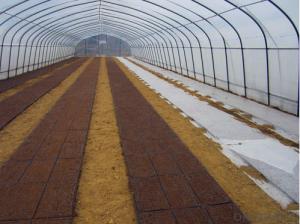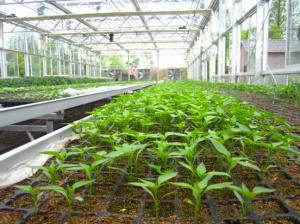Nursery Tray(Seed Tray,Nursery Tray,Planter Tray)
- Loading Port:
- China main port
- Payment Terms:
- TT or LC
- Min Order Qty:
- 1000 pc
- Supply Capability:
- 10000000 pc/month
OKorder Service Pledge
OKorder Financial Service
You Might Also Like
Structure of the seed tray:
· Top quality and competitive price.
· Variety design and good appearance.
· Easy to use, and remove.
· Durable and reusable.
· Eco-Friendly.
Description Main Features of the seed tray:
· Ideal for Starting seeds and Transplanting Seedling.
· Suitable for both manual and automatic planting.
· Suitable for Propagating Vegetables, Flowers and other plant from seed in green-house or indoors.
Thickness vs. Weight
· Thickness of trays are from 0.5mm to 1.0mm.
· 1.0mm: 155g±5g; 100pcs/ctn.
· 0.9mm: 140g±5g; 120pcs/ctn.
· 0.7mm: 110g±5g; 150pcs/ctn.
· 0.6mm: 95g±5g; 180pcs/ctn.
· 0.5mm: 80g±5g; 200pcs/ctn.
·
Using time:
· thickness of 0.5mm can be used 1 to 2 times.
· thickness of 0.6mm can be used 3 to 4 times.
· thickness of 0.7mm can be used 5 to 6 times.
· thickness of 0.8mm can be used 7 to 8 times.
· thickness of 0.9mm can be used 8 to 9 times.
· thickness of 1.0mm can be used 8 to 10 times.
Seed Tray Specification:
Material | ps/pvc |
Thickness | 0.5mm-1.5mm, standard:1mm |
Weight | 80g(±5)g-230g(±5)g, Standard weight:155g(±5)g |
Size | length:490mm-540mm, width:190mm-345mm,depth:25mm-150mm Standard:54mmX28mm |
Cell count | 18-512 |
Package | in carton |
Using time | 8-10 times |
FAQ:
Q:How Can I Get A Sample?
A:You can get samples by communicate with our export sales.
Q:How Long Is Delivery?
A:Delivery time will be 7-25 days according to order quantity.
Q:What Is The MOQ?
A:Our MOQ is 1*20FT container quantity, allow to mix several items.
Q:What Is Our Normal Payments Terms?
A:Our normal payment terms now is T/T, L/C or Western Union,Papal.
Q:How Do I Order Your Products?
A:You can check our website for any items you interest and you can also get communication with our export sales and order for it accordingly.
Q:What Kinds Of Material We Use In Our Product?
A:Our plastic flower pots use material such as PP polymer or PE polymer.
- Q: How do nursery trays help in maintaining proper air circulation around plant roots?
- Nursery trays help in maintaining proper air circulation around plant roots by providing adequate spacing between each plant, allowing air to flow freely. The design of these trays often includes drainage holes, which prevent waterlogging and promote aeration. This ensures that plant roots receive the necessary oxygen for healthy growth and prevents the development of root diseases caused by excessive moisture.
- Q: I did like to know how they make plastic bottle , oh so many of them. I do like to hear from you.Thank you.
- plastic begins as petroleum, they refine the petroleum to make many kinds of plastics.
- Q: How long do agricultural plastic products last?
- The lifespan of agricultural plastic products can vary depending on various factors such as the type of plastic used, environmental conditions, and usage patterns. However, on average, agricultural plastic products can last anywhere from a few months to several years.
- Q: YOU THINK PEOPLE CAN TURN GOOD LOOKING WHIT OUT plastic surgery
- Yes as long as they don't over due it.
- Q: What are the benefits of using plastic plant pots for nursery plants?
- There are several benefits to using plastic plant pots for nursery plants. Firstly, plastic pots are lightweight and easy to handle, making them convenient for transporting and rearranging plants. Additionally, plastic pots are durable and long-lasting, ensuring that they won't break or deteriorate easily. Plastic pots also provide good insulation, protecting the roots of the plants from extreme temperatures. Moreover, plastic pots retain moisture better than other materials, reducing the frequency of watering required. Lastly, plastic pots are cost-effective and readily available, making them a practical choice for nursery plants.
- Q: I just got asked this at the store when I was buying my groceries ( I got beans, doritos, twinkies). What's more environmentally friendly, I know you I can put paper bags in my bonfire, but what about plastic?
- Paper 'cause plastic can suffocate the ugly.
- Q: How are plastic poultry incubators used for hatching chicks?
- Plastic poultry incubators are used for hatching chicks by providing a controlled and suitable environment for the eggs to develop and hatch. The incubator maintains the necessary temperature, humidity, and ventilation levels required for successful incubation. Eggs are placed in trays or racks within the incubator, and the machine ensures a consistent and optimal environment for the eggs to hatch into healthy chicks.
- Q: 1. What is the average salary of a plastic surgeon?2. What is the average salary of a plastic surgeon in California?3. What is the average salary of a plastic surgeon in Ohio?
- I really dont know but its alot...(2 points!)
- Q: What are the different types of agricultural plastic covers for hay and silage?
- There are several different types of agricultural plastic covers for hay and silage, including bale wrap, silage bags, and bunker covers. Bale wrap is a stretchable plastic film that is used to tightly encase individual hay or silage bales, protecting them from moisture and preserving the quality of the forage. Silage bags are large plastic tubes that are filled with chopped forage and sealed to create an airtight environment for fermentation. Bunker covers are heavy-duty plastic sheets that are used to cover large stacks or piles of hay or silage, providing protection from the elements and helping to maintain the nutritional value of the stored forage.
- Q: Can nursery trays be used for air layering?
- Yes, nursery trays can be used for air layering. The trays provide a convenient and organized way to propagate plants through air layering, allowing for easy monitoring and care of the rooted cuttings.
Send your message to us
Nursery Tray(Seed Tray,Nursery Tray,Planter Tray)
- Loading Port:
- China main port
- Payment Terms:
- TT or LC
- Min Order Qty:
- 1000 pc
- Supply Capability:
- 10000000 pc/month
OKorder Service Pledge
OKorder Financial Service
Similar products
Hot products
Hot Searches
Related keywords
































